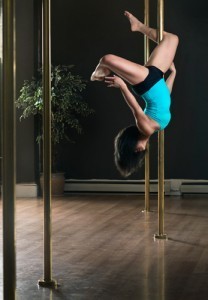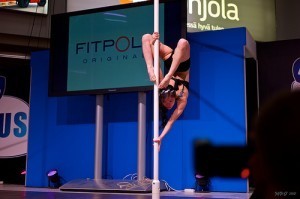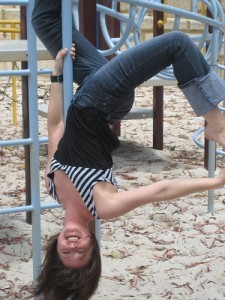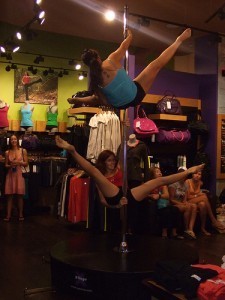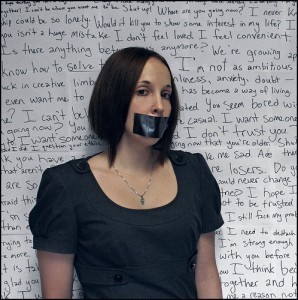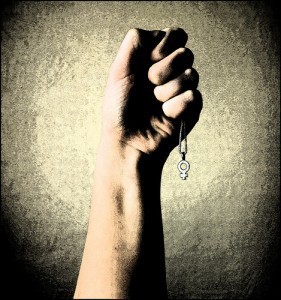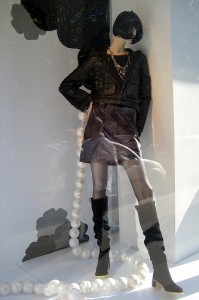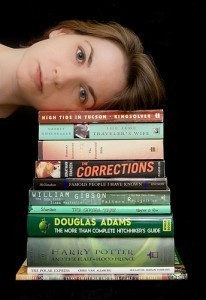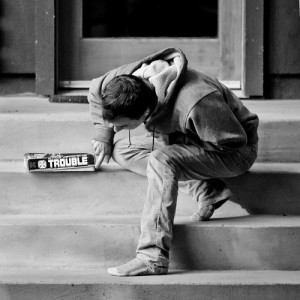Justine Musk's Blog, page 14
April 1, 2013
10 power lessons about creativity from an unexpected source
“Dance first. Think later. It’s the natural order.” ― Samuel Beckett
I was at a dinner party in Beverly Hills when the hostess surprised us all with a visit from a poledancer.
The poledancer was not a stripper. She was a dancer and athlete who had recently won some kind of national poledancing championship. She spun her body around the pole like an acrobat, we applauded wildly, and she offered to teach us a move or two.
I eagerly volunteered, despite a back that was acting up. (You can see it in this video clip, which ends with a move I invented myself and like to call, Oh f*ck, my back.)
Then I started thinking about what poledancing can teach us about creativity.
I give you:
1. the power of reframing
A frame is the network of assumptions and expectations through which you view the world. It colors how you experience life (and how life experiences you). As Keith Sawyer points out in his book ZIG ZAG, a frame is like a mental shortcut, a quick way to answer the question What’s going on here?
We use it to assign meaning to a situation, figure out the intentions of the players, and predict outcomes and consequences.
One way to think differently – and more creatively – about a situation is to reinvent the way you view it.
Since a frame is about what you exclude as well as what you include, a reframe can open up new possibilities by showing you something that wasn’t there before, by incorporating new information or shifting your area of focus.
You can think of poledancing through a framework of strip clubs and prostitution, exploitation and degradation. Or you can reframe it as physical exercise that builds upper body strength and serious abs – not to mention is also a fun way to bond with your girlfriends.
Sheila Kelley reframes poledancing as a form of creative self-expression – and a feminist act. It’s a way for a woman to reclaim the sensuality that cultures the world over attempt to own, control and constrict. This is a powerful reframe (whether or not you agree with it) that not only flips poledancing from a symbol of degradation to one of liberation – but enabled Kelley to transform from actress to entrepreneur.
When you take a problem that has bamboozled you and find ways to reframe it, you find new ways to see, perceive and think about it. This could lead not just to a solution but a revolutionary new insight.
2. The power of being in your body
I have come to believe that sensuality and creativity are connected. Being in your body is about being alive to the moment: dropping out of whatever story you’re telling yourself in your head and experiencing the world through your senses, your feelings, yourself as a physical being.
You stop obsessing over the past or leaning into the future.
You are right here right now.
This allows the mind to calm the f*ck down, and the result is more than a sense of contentment and well-being. It involves the ability to see with fresh eyes and become more aware.
Professor Ellen Langer of Harvard studies what she calls mindfulness. It’s the ability to switch out of automatic pilot and into a state of active observation. Being “mindless” is an efficient way to get through the usual tasks and routines of day-to-day living. But it also traps us in predictability and sameness.
According to Langer, what sets artists apart from other people is their ability to step out of the frames and smash the mental categories through which other people process the world.
Artists have vision – and the ability to re/vision.
When you’re in your body, you can also listen to your body – those hunches, gut feelings, and flashes of nonverbal intelligence that deepen your understanding of where you are now and what your next move should be.
3. the power of mastering the moves
Creativity has a social context. Each field has its own set of experts with its own set of notions about what is traditional, conservative or cutting edge. In order to be creative in your particular field, it helps to have a level of domain knowledge: the deeper that knowledge goes, the more creative you have the potential to be. (Harvard psychologist Howard Gardner has proven that creative individuals tend to come up with major breakthroughs after ten years of deep involvement in their chosen field.)
In other words: I have very little ability to bust out some truly innovative poledancing moves because I don’t know what the hell I’m doing. I like to dance but I am not a trained dancer, acrobat or gymnast. (I am merely a book nerd.) I have no domain knowledge from which to draw ideas for a supercool poledancing routine.
As Cal Newport puts it: you have to master the rules before you can reinvent them.
4. the power of combining (and recombining) the moves
Creativity, as Steve Jobs so famously said, is about connecting things. It’s about taking different ideas and finding ways to take them apart and combine or recombine them (or elements of them).
In the case of poledancing, you learn the moves (domain knowledge) and then practice ways of putting them together that reflect your own personality. The more moves you master — the more your body absorbs the technique — the more and better raw material you’ll have through which to express yourself. Your style might be gymnastic, sensual or street – or something still waiting for you to invent.
5. the power of adding up little gains
Mastery doesn’t arrive all at once. You learn the moves one at a time. You have little personal breakthroughs, and days go by when you don’t feel like you’re breaking anything at all (except maybe your head against a brick wall).
It’s just part of the process.
When Keith Sawyer immersed himself in a study of creativity (resulting in the excellent book ZIG ZAG), he discovered that no matter what kind of creativity he studied, the process came out the same. Creativity did not light up the world – or the creator’s mind — in one single flash.
Or maybe it did – but as the accumulated result of years of effort.
Baby steps.
Fragments of insight.
Tiny changes.
You learn and study and ponder and practice and seek out criticism and adjust and grow and rinse and repeat. You can’t whisk yourself from Point A (total amateur) to Point Z (dazzling genius) without working your way through the letters in between. Creativity is not a teleportation device. It is, instead, a series of little gains — actions and insights – that link up into a chain that slowly but steadily lengthens across the creative gap: that vast sweep of distance between where you begin and where you want to end up.
As Gordon Gould describes his invention of the laser: “…I [suddenly] saw how to build a laser…But that flash of insight required the twenty years of work I had done in physics and optics to put all the ‘bricks’ of the invention in there.”
6. the power of refusing to compare yourself with others
This is so easy to say, I know, and difficult to do. Aside from the fact that comparing yourself to others will depress you and wither away your soul, it’s not practical. Someone who is 5’9’’ is going to put together a different routine and excel in different ways (and be limited in different ways) than someone who is 5’3’’.
Strengths and weaknesses are flip sides of the same coin. At 5’5’’, Svetlana Khorkina was almost unthinkably tall for an elite female gymnast.
She had to modify certain moves that the other, smaller gymnasts could do, such as doing multiple twists in the air instead of somersaults. Her height and her moves helped make her a standout, and she is regarded as one of the best gymnasts of all time.
Comparison, as Youngme Moon points out in her book DIFFERENT, is dangerous — because it means that everyone starts to compete along the same criteria. Sooner or later the differences level off and everyone starts to seem the same.
It’s better (and infinitely more interesting) to find the qualities unique to you — that set you apart — and develop them to advantage.
Hint: those qualities are linked to whatever people accused you of being too much of when you were growing up. For example: I was too scattered, absent-minded, and disorganized – the flipside to being unusually creative. I was also too intense, too serious, I used too many big words, and I thought too much (whatever that means).
My passion, my intellect and my ability to consume and synthesize information marked me ‘different’ as a kid, but serve me very well as an adult.
(I remember Kim Basinger saying in an interview how kids at school used to tease her for having such big lips. She would go home crying, and her father would tell her that one day her lips would be worth a million dollars. He wasn’t exactly wrong.)
7. the power of creating a safe environment
I’m not sure if anything inhibits creative expression like the fear of shame and judgment.
Fear keeps us locked into conservative thinking. In the face of thoughtless criticism, we shut down. We keep our thoughts and talents to ourselves.
Places like The S Factor stress a safe and supportive environment in which a woman can unleash her inner “erotic animal”. This frees her up to take risks, try new things, and learn and evolve.
Whenever you’re trying to create something, to innovate, to break through with new insights and ideas, take a look at your environment. Is it populated with people who are quick to shout you down or deflate you? (Are you quick to shout yourself down or deflate your own ideas before you even have a chance to get started? How do you talk to yourself, and would you talk to anyone else like that?)
Do you have a space where you can go, shut the door, and feel safe enough to play, let your mind roam, explore your ragged creative edge?
8. the power of playing
The thing about poledancing is that it’s fun. You can play around with the moves and find different ways to express yourself. You can take chances, experiment, and learn something new. When you hear the women in The S Factor’s advanced poledancing classes whooping and hollering, you know about all else they are having a great time.
Tim Brown has a great TED talk about “serious play”, in which he points out that play is only possible when you can relax and be light-hearted with the people around you. It’s why friendship, as Brown points out, “is a shortcut to play”.
When we’re trusting of our environment, we open ourselves up to new ways of exploring it.
Dan Goodwin defines superpowers as “the naturally occurring abilities we purposefully foster that amplify our human potential.” To succeed in a creative economy, we need to know how to
manipulate (deconstruct and hack), morph (think flexibly and be tolerant of change), and move (think “with [your] hands” and play productively…. [also] to see (observe and imagine), sense (have empathy and intrinsic motivation), and stretch (think abstractly and systemically).
We must “advance our abilities to collaborate and create.”
(Today, poledancing class: tomorrow, the world.)
9. the power of building in a feedback loop
You could get a DVD or download videos off the Internet and learn to poledance on your own, but isolation cuts you off from feedback – and limits your growth.
Mastery doesn’t require hours of practice — it requires hours of deliberate practice. Deliberate practice is when you’re working off your ragged edge, striving to achieve something that is just – beyond – your ability to grasp it – until suddenly it isn’t.
You’ve evolved.
Good, constructive, supportive feedback keeps you honest. It helps you correct and improve your technique as you go. It teaches you what is working, what you can build on – and what you should let go. Feedback keeps you tethered to the reality outside your own head. Delusions get shot down before they have a chance to thrive (many of us resist feedback for this very reason).
The fastest way to master anything is to be teachable: to seek out coaches and mentors and listen to what they have to say, even (or especially) when it means you have to check your ego at the door.
10. the power of being vulnerable
There’s no getting around it. To grow as a creative, you have to put yourself out there. It isn’t the surface, superficial stuff – the glib social persona – that truly moves people, that gets inside their soul and shakes up the way they see the world. If you want to resonate, if you want to make a difference, you have to show us something we’ve never seen before. You have to show us who you are.
(The great thing is — when you show who you are, you give other people permission to do the same. And they will.)
I love – the ironic, rolling-my-eyes kind of love – when people tell you to just be yourself. It seems like such simple, even simplistic advice – and yet if it was really that easy, would we have to keep advising and reminding each other to do it?
It’s one thing to know who you are (a challenge in itself). It’s another thing to master the tools and develop the skills that allow you to present yourself in a way that’s both honest and authentic to who you are – and relevant to other people (or else why should they even care?).
Being yourself involves an element of exposure: taking your inner life and opening it up to friends and strangers. When this is done in an authentic and relevant way, it connects with your audience’s inner life – and creates a sense of resonance. A sense not just of connection, but identification.
Great creative work not only shows us something new, it reminds us who we are — and that we’re not alone. Someone else “gets” us – which means they must be one of us. It connects us to the larger human community. It calls us home.





how to be creative: 10 power lessons from an unexpected source
“Dance first. Think later. It’s the natural order.” ― Samuel Beckett
I was at a dinner party in Beverly Hills when the hostess surprised us all with a visit from a poledancer.
The poledancer was not a stripper. She was a dancer and athlete who had recently won some kind of national poledancing championship. She spun her body around the pole like an acrobat, we applauded wildly, and she offered to teach us a move or two.
I eagerly volunteered, despite a back that was acting up. (You can see it in this video clip, which ends with a move I invented myself and like to call, Oh f*ck, my back.)
Then I started thinking about what poledancing can teach us about creativity.
I give you:
1. the power of reframing
A frame is the network of assumptions and expectations through which you view the world. It colors how you experience life (and how life experiences you). As Keith Sawyer points out in his book ZIG ZAG, a frame is like a mental shortcut, a quick way to answer the question What’s going on here?
We use it to assign meaning to a situation, figure out the intentions of the players, and predict outcomes and consequences.
One way to think differently – and more creatively – about a situation is to reinvent the way you view it.
Since a frame is about what you exclude as well as what you include, a reframe can open up new possibilities by showing you something that wasn’t there before, by incorporating new information or shifting your area of focus.
You can think of poledancing through a framework of strip clubs and prostitution, exploitation and degradation. Or you can reframe it as physical exercise that builds upper body strength and serious abs – not to mention is also a fun way to bond with your girlfriends.
Sheila Kelley reframes poledancing as a form of creative self-expression – and a feminist act. It’s a way for a woman to reclaim the sensuality that cultures the world over attempt to own, control and constrict. This is a powerful reframe (whether or not you agree with it) that not only flips poledancing from a symbol of degradation to one of liberation – but enabled Kelley to transform from actress to entrepreneur.
When you take a problem that has bamboozled you and find ways to reframe it, you find new ways to see, perceive and think about it. This could lead not just to a solution but a revolutionary new insight.
2. The power of being in your body
I have come to believe that sensuality and creativity are connected. Being in your body is about being alive to the moment: dropping out of whatever story you’re telling yourself in your head and experiencing the world through your senses, your feelings, yourself as a physical being.
You stop obsessing over the past or leaning into the future.
You are right here right now.
This allows the mind to calm the f*ck down, and the result is more than a sense of contentment and well-being. It involves the ability to see with fresh eyes and become more aware.
Professor Ellen Langer of Harvard studies what she calls mindfulness. It’s the ability to switch out of automatic pilot and into a state of active observation. Being “mindless” is an efficient way to get through the usual tasks and routines of day-to-day living. But it also traps us in predictability and sameness.
According to Langer, what sets artists apart from other people is their ability to step out of the frames and smash the mental categories through which other people process the world.
Artists have vision – and the ability to re/vision.
When you’re in your body, you can also listen to your body – those hunches, gut feelings, and flashes of nonverbal intelligence that deepen your understanding of where you are now and what your next move should be.
3. the power of mastering the moves
Creativity has a social context. Each field has its own set of experts with its own set of notions about what is traditional, conservative or cutting edge. In order to be creative in your particular field, it helps to have a level of domain knowledge: the deeper that knowledge goes, the more creative you have the potential to be. (Harvard psychologist Howard Gardner has proven that creative individuals tend to come up with major breakthroughs after ten years of deep involvement in their chosen field.)
In other words: I have very little ability to bust out some truly innovative poledancing moves because I don’t know what the hell I’m doing. I like to dance but I am not a trained dancer, acrobat or gymnast. (I am merely a book nerd.) I have no domain knowledge from which to draw ideas for a supercool poledancing routine.
As Cal Newport puts it: you have to master the rules before you can reinvent them.
4. the power of combining (and recombining) the moves
Creativity, as Steve Jobs so famously said, is about connecting things. It’s about taking different ideas and finding ways to take them apart and combine or recombine them (or elements of them).
In the case of poledancing, you learn the moves (domain knowledge) and then practice ways of putting them together that reflect your own personality. The more moves you master — the more your body absorbs the technique — the more and better raw material you’ll have through which to express yourself. Your style might be gymnastic, sensual or street – or something still waiting for you to invent.
5. the power of adding up little gains
Mastery doesn’t arrive all at once. You learn the moves one at a time. You have little personal breakthroughs, and days go by when you don’t feel like you’re breaking anything at all (except maybe your head against a brick wall).
It’s just part of the process.
When Keith Sawyer immersed himself in a study of creativity (resulting in the excellent book ZIG ZAG), he discovered that no matter what kind of creativity he studied, the process came out the same. Creativity did not light up the world – or the creator’s mind — in one single flash.
Or maybe it did – but as the accumulated result of years of effort.
Baby steps.
Fragments of insight.
Tiny changes.
You learn and study and ponder and practice and seek out criticism and adjust and grow and rinse and repeat. You can’t whisk yourself from Point A (total amateur) to Point Z (dazzling genius) without working your way through the letters in between. Creativity is not a teleportation device. It is, instead, a series of little gains — actions and insights – that link up into a chain that slowly but steadily lengthens across the creative gap: that vast sweep of distance between where you begin and where you want to end up.
As Gordon Gould describes his invention of the laser: “…I [suddenly] saw how to build a laser…But that flash of insight required the twenty years of work I had done in physics and optics to put all the ‘bricks’ of the invention in there.”
6. the power of refusing to compare yourself with others
This is so easy to say, I know, and difficult to do. Aside from the fact that comparing yourself to others will depress you and wither away your soul, it’s not practical. Someone who is 5’9’’ is going to put together a different routine and excel in different ways (and be limited in different ways) than someone who is 5’3’’.
Strengths and weaknesses are flip sides of the same coin. At 5’5’’, Svetlana Khorkina was almost unthinkably tall for an elite female gymnast.
She had to modify certain moves that the other, smaller gymnasts could do, such as doing multiple twists in the air instead of somersaults. Her height and her moves helped make her a standout, and she is regarded as one of the best gymnasts of all time.
Comparison, as Youngme Moon points out in her book DIFFERENT, is dangerous — because it means that everyone starts to compete along the same criteria. Sooner or later the differences level off and everyone starts to seem the same.
It’s better (and infinitely more interesting) to find the qualities unique to you — that set you apart — and develop them to advantage.
Hint: those qualities are linked to whatever people accused you of being too much of when you were growing up. For example: I was too scattered, absent-minded, and disorganized – the flipside to being unusually creative. I was also too intense, too serious, I used too many big words, and I thought too much (whatever that means).
My passion, my intellect and my ability to consume and synthesize information marked me ‘different’ as a kid, but serve me very well as an adult.
(I remember Kim Basinger saying in an interview how kids at school used to tease her for having such big lips. She would go home crying, and her father would tell her that one day her lips would be worth a million dollars. He wasn’t exactly wrong.)
7. the power of creating a safe environment
I’m not sure if anything inhibits creative expression like the fear of shame and judgment.
Fear keeps us locked into conservative thinking. In the face of thoughtless criticism, we shut down. We keep our thoughts and talents to ourselves.
Places like The S Factor stress a safe and supportive environment in which a woman can unleash her inner “erotic animal”. This frees her up to take risks, try new things, and learn and evolve.
Whenever you’re trying to create something, to innovate, to break through with new insights and ideas, take a look at your environment. Is it populated with people who are quick to shout you down or deflate you? (Are you quick to shout yourself down or deflate your own ideas before you even have a chance to get started? How do you talk to yourself, and would you talk to anyone else like that?)
Do you have a space where you can go, shut the door, and feel safe enough to play, let your mind roam, explore your ragged creative edge?
8. the power of playing
The thing about poledancing is that it’s fun. You can play around with the moves and find different ways to express yourself. You can take chances, experiment, and learn something new. When you hear the women in The S Factor’s advanced poledancing classes whooping and hollering, you know about all else they are having a great time.
Tim Brown has a great TED talk about “serious play”, in which he points out that play is only possible when you can relax and be light-hearted with the people around you. It’s why friendship, as Brown points out, “is a shortcut to play”.
When we’re trusting of our environment, we open ourselves up to new ways of exploring it.
Dan Goodwin defines superpowers as “the naturally occurring abilities we purposefully foster that amplify our human potential.” To succeed in a creative economy, we need to know how to
manipulate (deconstruct and hack), morph (think flexibly and be tolerant of change), and move (think “with [your] hands” and play productively…. [also] to see (observe and imagine), sense (have empathy and intrinsic motivation), and stretch (think abstractly and systemically).
We must “advance our abilities to collaborate and create.”
(Today, poledancing class: tomorrow, the world.)
9. the power of building in a feedback loop
You could get a DVD or download videos off the Internet and learn to poledance on your own, but isolation cuts you off from feedback – and limits your growth.
Mastery doesn’t require hours of practice — it requires hours of deliberate practice. Deliberate practice is when you’re working off your ragged edge, striving to achieve something that is just – beyond – your ability to grasp it – until suddenly it isn’t.
You’ve evolved.
Good, constructive, supportive feedback keeps you honest. It helps you correct and improve your technique as you go. It teaches you what is working, what you can build on – and what you should let go. Feedback keeps you tethered to the reality outside your own head. Delusions get shot down before they have a chance to thrive (many of us resist feedback for this very reason).
The fastest way to master anything is to be teachable: to seek out coaches and mentors and listen to what they have to say, even (or especially) when it means you have to check your ego at the door.
10. the power of being vulnerable
There’s no getting around it. To grow as a creative, you have to put yourself out there. It isn’t the surface, superficial stuff – the glib social persona – that truly moves people, that gets inside their soul and shakes up the way they see the world. If you want to resonate, if you want to make a difference, you have to show us something we’ve never seen before. You have to show us who you are.
(The great thing is — when you show who you are, you give other people permission to do the same. And they will.)
I love – the ironic, rolling-my-eyes kind of love – when people tell you to just be yourself. It seems like such simple, even simplistic advice – and yet if it was really that easy, would we have to keep advising and reminding each other to do it?
It’s one thing to know who you are (a challenge in itself). It’s another thing to master the tools and develop the skills that allow you to present yourself in a way that’s both honest and authentic to who you are – and relevant to other people (or else why should they even care?).
Being yourself involves an element of exposure: taking your inner life and opening it up to friends and strangers. When this is done in an authentic and relevant way, it connects with your audience’s inner life – and creates a sense of resonance. A sense not just of connection, but identification.
Great creative work not only shows us something new, it reminds us who we are — and that we’re not alone. Someone else “gets” us – which means they must be one of us. It connects us to the larger human community. It calls us home.





March 27, 2013
how to blog like you mean to change the world
We shall not cease from exploration. And the end of all our exploring. Will be to arrive where we started. And know the place for the first time.
— T.S. Eliot
1
Transformation is a point in the journey, a shift in the paradigm, a change in the way you see yourself.
We construct ourselves according to the stories we tell ourselves ( and others) about our lives. What happens when you reinterpret those stories? Or help your reader do the same? When you discover a new belief about yourself, or jettison an old one that no longer serves you?
Blogging is a form of marketing – we are marketing our work, ourselves as creators – but true marketing (or unmarketing) isn’t just some shallow, slapped-on attempt at self-promotion. (This is otherwise known as bad marketing.) It’s about making an emotional connection with the people whom you are meant to serve: your audience.
So first you have to identify your audience. Then you have to figure out how and where to reach them – and make them come to you, which they will do, happily, if you give them a valid reason.
If you can teach, entertain, inspire. If you can create content that actually means something.
It comes down to the kinds of questions you ask.
Who do you want your readers to become?
How can you inspire and empower them to become that?
The ironic thing is that although a creative platform promotes yourself and your work, it’s not actually about either of those things.
It’s about your reader.
You are not the hero of this story. The reader is.
You are, instead, the mentor figure, helping the reader become the person that he or she needs to be in order to get the thing for which he or she is striving.
This is why, as a blogger, you need some authority on your side: the reader needs to find you credible in this role. You need to be farther along on the journey – or better yet, to embody it in some way. To be walking your talk. To be living out the very values you espouse in your blog. This grants you the charisma to move ahead of the pack, into a striking bit of territory unique to you.
2
John Hagel makes the distinction between story and narrative.
1. Stories are finite: they have a beginning, a middle, and an end resolution.
2. Stories center on a protagonist. You are meant to identify with that character.
The inherent message is Listen.
1. Narratives are open-ended. They lack resolution. They are in the very process of unfolding.
2. They invite you to participate and determine the outcome. It’s up to you to help shape how this story will end.
The inherent message is Join.
“Narratives motivate actions,” Hagel notes. “In some cases, they motivate life and death choices…Every powerful movement that has impacted our world has been shaped and energized by a potent narrative.”
A narrative pulls the reader into the hero role, and you, as mentor, give her the tools, gifts and knowledge that enable her quest.
Hagel makes the point that narratives happen on personal, institutional and social levels. These narratives nestle inside each other like Russian dolls.
Think about Apple’s “Think Different” campaign. It unfolds inside a larger narrative that presents American society as an enemy, threatening to submerge you in an ocean of conformity. Apple urges you – the creative rebel hero — to resist, through reclaiming your true identity and battling the forces of sameness.
They offer you the tools to do this (at a price).
They empower you to live out your own personal narrative of creative rebellion, to create new stories about you that identify you in this way.
I challenge you to identify the personal and social narratives that you are living out in your own life. What do they say about who you are, what you want, and how you view the world?
I challenge you to create a narrative for your blog – or your creative work in general – that puts your audience front and center.
You’re not simply addressing the reader as she is, but who she aspires to be .
Your blog becomes a way of calling out your reader’s higher self. click to tweet
In Ernest Becker’s Pulitzer Prize-winning work THE DENIAL OF DEATH, he says the reason we respond so strongly to heroes is because we secretly yearn to be heroes ourselves.
We yearn for a heroic life. We know we’re meant for bigger things.
Find a way to connect your reader to the hero within her. Create in a way that serves her hero’s journey, and you’re not just painting a picture or starting a company or writing a novel or posting a blog.
You’re building out a new mythology.
You’re feeding a collective soul-hunger.
That’s the kind of thing that changes a life. Or a culture. Or a world.





March 25, 2013
the real journey of a writer
The real journey of a writer – or any creative – isn’t to publication, rewards, acclaim, but to your own voice.
When you find your voice, you connect to yourself, and then through yourself to the world. Your work resonates. As Thoreau once wrote in his journal, “The whole is in each man.” (And each woman.)
I’ve always felt that your voice is twofold: not just how you write, but what you write about. They inform and shape each other.
You need to read, look, listen, absorb. You need to take the world into you so you can reinvent it through your own point of view.
You need to tune out external voices that speak in the language of the shoulds – you should do this, you should do that – and move into the secret life of your intuition. This other life has its own mind. It will guide you to places that, because they are yours, remain – as yet — unknown and uncharted. For all the self-help and how-to that fills our culture, success is, in the end, as unique to you as a fingerprint. You can only make that path by walking it. It unfolds in front of you. Sometimes it carries you along.
So you need to write.
And write.
And write.
You need to write past the point of self-consciousness. You need to quit trying to write: to be clever, witty, pretty, poetic. (Perhaps your true voice is none of these things.) You need to fall through the words into something else entirely.
(Blogging can be exceptionally good for this.)
We start by imitating the styles of others. That kind of mimicry – conscious or not – is like a trapdoor opening beneath you.
It drops you into yourself.
It’s when you lose yourself that your true voice starts to come out of the dark. It might be raw and naked. Or howling and slightly mad. Your soul is stamped all the way through it.
Finding your voice – what to say, how to say it, how to speak up in the world – is about making your truth manifest. When you’re moving in the grooves of that soulprint, you know it. And so do others.
This is art.
Art happens wherever your soul’s on the line. click to tweet





March 23, 2013
the secret dharma of women
1
Sometimes you’re damned if you do and damned if you don’t.
Women in my generation grew up with the message you can be anything you want to be….except when you can’t. That last part was beamed at us through images of successful women who are harried, lonely and miserable and successful women who realized they forgot to have families and successful women who are mocked in the media for their less-than-supermodel appearance and “castrating” nature.
A book came out with a title that said it all. Although the message was pro-women and pro-ambition, the title was AM-BITCH-OUS. (Later changed.)
Even when the word ‘bitch’ is supposedly reclaimed and framed in positive terms – embrace your inner bitch! – you can’t blame a woman for shrugging her shoulders and saying, Well, maybe not so much.
The problem is that bitches aren’t likeable. The problem is that likeability plays an important role in success: if you aren’t likeable, it’s a lot harder to get ahead. The problem is that, for women, the more successful she is, the more she is perceived as being “like a man” – out for her own interests instead of sacrificing herself to serve the needs of others – which makes her an object of general distrust.
People don’t want to do business with people they distrust.
2
So women won’t ask for raises or negotiate on their own behalf, knowing intuitively that it might damage their reputation and hurt them in the long run. (Then of course women get criticized for refusing to ask for raises or negotiate for themselves, which implies that the so-called glass ceiling is conveniently their fault.)
I suspect that among the relatively small number of women who rose to fame in the last century or so (outside of acting/modeling), a disproportionate percentage of them were total narcissists.
Ayn Rand and Coco Chanel spring to mind: women with bold and visionary points of view and the courage to defy a culture that would keep them in their place. They would have been regarded, by many, as freakish spawns of hell — and they would not have given a damn. The only opinion that truly matters to a narcissist is the narcissist’s.
(I once became friends with one of the most notorious figures of pop culture, idolized by some but loathed and despised by many. Happily for him, he was narcissistic enough to be oblivious to much of the contempt and criticism that came his way. He saw himself as a hero – maligned and misunderstood, fighting the hypocritical powers-that-be – and the idea that others might not was mystifying to him. But I digress.)
Most women aren’t narcissists, and if forced to choose between being successful and being liked or loved, they’ll come down on the side of relationships every time. Given that the quality of your happiness and even your health depends upon the quality of your relationships, this doesn’t seem like a choice women make so much as an act of psychological survival.
I don’t believe that women are inherently less ambitious than men. Anyone who thinks that females aren’t interested in status and power should take a refresher course in junior high social politics. I certainly don’t believe that women are inherently less creative than men (if Shakespeare had a sister, she got waylaid by housework, pregnancy and childraising).
I believe that men and women both are biologically wired to compete for status (to ensure the survival of ourselves and our offspring) and to play and create (to ensure that we learn, practice and advance as individuals and as a species).
We grow up in a culture that quickly divorces our ambitions from the notion of being feminine unless they are channeled into appearance, securing and keeping a mate, and motherhood. In fact, we’re criticized if we don’t exhaustively strive in those areas, let alone step out of the race altogether.
3
We are allowed to advocate for others. Studies show that when it comes to negotiating for other people, women prove just as capable as men.
We’re just not allowed to advocate for ourselves.
But if this is the problem, maybe it’s also the solution.
Maybe the problem is how we frame ambition in the first place. click to tweet
We don’t seem to connect the success of our lives as individuals to the success of ourselves as a group – or as a gender. For those who think that ambition and power are overrated, overly masculine notions that should be eschewed at all costs, I give you a paragraph from Sheryl Sandberg’s book LEAN IN:

“The night before Leymah Gbowee won the 2011 Nobel Peace Prize for helping to lead the women’s protests that toppled Liberia’s dictator, she was at a book party in my home…A guest asked her how American women could help those who experienced the horrors and mass rapes of war in places like Liberia. Her response was four simple words: ‘More women in power.’….Conditions for all women will improve when there are more women in leadership roles giving strong and powerful voice to their needs and concerns.” (emphasis is mine)
Sandberg advises women to “think personally, act communally”: to preface negotiations by
“explaining that they know that women often get paid less than men so they are going to negotiate rather than accept the original offer. By doing so, women position themselves as connected to a group and not just out for themselves; in effect, they are negotiating for all women.”
Sandberg presents this as a personal strategy, but I can’t help thinking that it’s true.
4
The first time I ever , more than one woman suggested that we come up with another word for ‘ambition’. They found the concept that distasteful.
I think now of Stephen Cope’s definition of dharma. Dharma, he writes, “is a potent Sanskrit word that is packed tight with meaning” such as path, teaching or law.
For his own purposes he defines dharma primarily as vocation or sacred duty.
The idea that you can be anybody you want to be – whether you’re a man or a woman – is a popular cultural myth. You arrive in this world encoded with certain gifts – and certain limitations. You can identify and develop these gifts and find ways of circumventing your limitations in order to become, not anyone, but fully who you already are.
You come home to your true self.
Above all, Cope stresses that dharma means truth. To fulfill your dharma is to live out your personal truth.
But dharma is twofold. It’s not enough to express and develop your gifts.
You must take your gifts into the world in order to serve and contribute. (What good is a cure for cancer if you keep it to yourself?) How you do this depends on the call of the times: the context, your context, of time and place and events. Part of discovering your dharma is listening for that call and the willingness to hear it in the first place.
Dharma also shifts and changes as your own life changes: the quest to fulfill your dharma might not happen just once, but multiple times throughout your lifetime. There might be a point where you say that you don’t have the time or energy or space or money or youth; dharma says none of that matters. No excuses. It is your sacred duty to completely and utterly embody your own unique brand of dharma.
Because ambition – or dharma – doesn’t happen in a vacuum. Actions ripple out and through a much larger picture. We are all knitted together in what American philosopher Alan Watts envisioned as a multidimensional spiderweb. Imagine it covered with dewdrops, he wrote. And inside every dewdrop is the reflection of every one dewdrop, and inside that reflection is the reflection of every one dewdrop, and so on, and so on….
Point being: any change in a single dewdrop becomes reflected in the whole.
Our actions, writes Cope,
“connect us to the soul of the world. They create the world. Small as they may appear, they have the power to uphold the essential inner order of the world.”
As women, we might roll our eyes at the notion of a global sisterhood. Hell, you might be one of those women who likes to say that she prefers the company of guys. It doesn’t matter. You’re in the web regardless.
Four simple words: more women in power.
Maybe your dharma is to claim it for yourself. Maybe your dharma is to help another woman to power: to inspire or mentor or smooth the way. When you win for yourself, you win for other women. When you advance, you take other women with you.
We got the vote. We got the Pill. Now let’s get the power.





the secret dharma of women: how to come home to your true self
1
Sometimes you’re damned if you do and damned if you don’t.
Women in my generation grew up with the message you can be anything you want to be….except when you can’t. That last part was beamed at us through images of successful women who are harried, lonely and miserable and successful women who realized they forgot to have families and successful women who are mocked in the media for their less-than-supermodel appearance and “castrating” nature.
A book came out with a title that said it all. Although the message was pro-women and pro-ambition, the title was AM-BITCH-OUS. (Later changed.)
Even when the word ‘bitch’ is supposedly reclaimed and framed in positive terms – embrace your inner bitch! – you can’t blame a woman for shrugging her shoulders and saying, Well, maybe not so much.
The problem is that bitches aren’t likeable. The problem is that likeability plays an important role in success: if you aren’t likeable, it’s a lot harder to get ahead. The problem is that, for women, the more successful she is, the more she is perceived as being “like a man” – out for her own interests instead of sacrificing herself to serve the needs of others – which makes her an object of general distrust.
People don’t want to do business with people they distrust.
2
So women won’t ask for raises or negotiate on their own behalf, knowing intuitively that it might damage their reputation and hurt them in the long run. (Then of course women get criticized for refusing to ask for raises and to negotiate for themselves, which implies that the so-called glass ceiling is conveniently their fault.)
I suspect that among the relatively small number of women who rose to fame in the last century or so (outside of acting/modeling), a disproportionate percentage of them were total narcissists.
Ayn Rand and Coco Chanel spring to mind: women with bold and visionary points of view and the courage to defy a culture that would keep them in their place. They would have been regarded, by many, as freakish spawns of hell — and they would not have given a damn. The only opinion that truly matters to a narcissist is the narcissist’s.
(I once became friends with one of the most notorious figures of pop culture, idolized by some but loathed and despised by many. Happily for him, he was narcissistic enough to be oblivious to much of the contempt and criticism that came his way. He saw himself as a hero – maligned and misunderstood, fighting the hypocritical powers-that-be – and the idea that others might not was mystifying to him. But I digress.)
Most women aren’t narcissists, and if forced to choose between being successful and being liked or loved, they’ll come down on the side of relationships every time. Given that the quality of your happiness and even your health depends upon the quality of your relationships – especially your friendships – this doesn’t seem like a choice women make so much as an act of psychological survival.
I don’t believe that women are inherently less ambitious than men. Anyone who thinks that females aren’t interested in status and power should take a refresher course in junior high social politics. I certainly don’t believe that women are inherently less creative than men (if Shakespeare had a sister, she got waylaid by housework, pregnancy and childraising).
I believe that men and women both are biologically wired to compete for status (to ensure the survival of ourselves and our offspring) and to play and create (to ensure that we learn, practice and advance as individuals and as a species).
We grow up in a culture that quickly divorces our ambitions from the notion of being feminine unless they are channeled into appearance, securing and keeping a mate, and motherhood. In fact, we’re criticized if we don’t exhaustively strive in those areas, let alone step out of the race altogether.
3
We are allowed to advocate for others. Studies show that when it comes to negotiating for other people, women prove just as capable as men.
We’re just not allowed to advocate for ourselves.
But if this is the problem, maybe it’s also the solution.
Maybe the problem is how we frame ambition in the first place. click to tweet
We don’t seem to connect the success of our lives as individuals to the success of ourselves as a group – or as a gender. For those who think that ambition and power are overrated, overly masculine notions that should be eschewed at all costs, I give you a paragraph from Sheryl Sandberg’s book LEAN IN:

“The night before Leymah Gbowee won the 2011 Nobel Peace Prize for helping to lead the women’s protests that toppled Liberia’s dictator, she was at a book party in my home…A guest asked her how American women could help those who experienced the horrors and mass rapes of war in places like Liberia. Her response was four simple words: ‘More women in power.’….Conditions for all women will improve when there are more women in leadership roles giving strong and powerful voice to their needs and concerns.” (emphasis is mine)
Sandberg advises women to “think personally, act communally”: to preface negotiations by
“explaining that they know that women often get paid less than men so they are going to negotiate rather than accept the original offer. By doing so, women position themselves as connected to a group and not just out for themselves; in effect, they are negotiating for all women.”
Sandberg presents this as a personal strategy, but I can’t help thinking that it’s true.
4
The first time I ever , more than one woman suggested that we come up with another word for ‘ambition’. They found the concept that distasteful.
I think now of Stephen Cope’s definition of dharma. Dharma, he writes, “is a potent Sanskrit word that is packed tight with meaning” such as path, teaching or law.
For his own purposes he defines dharma primarily as vocation or sacred duty.
The idea that you can be anybody you want to be – whether you’re a man or a woman – is a popular cultural myth. You arrive in this world encoded with certain gifts – and certain limitations. You can identify and develop these gifts and find ways of circumventing your limitations in order to become, not anyone, but fully who you already are.
You come home to your true self.
Above all, Cope stresses that dharma means truth. To fulfill your dharma is to live out your personal truth.
But dharma is twofold. It’s not enough to express and develop your gifts.
You must take your gifts into the world in order to serve and contribute. (What good is a cure for cancer if you keep it to yourself?) How you do this depends on the call of the times: the context, your context, of time and place and events. Part of discovering your dharma is listening for that call and the willingness to hear it in the first place.
Dharma also shifts and changes as your own life changes: the quest to fulfill your dharma might not happen just once, but multiple times throughout your lifetime. There might be a point where you say that you don’t have the time or energy or space or money or youth; dharma says none of that matters. No excuses. It is your sacred duty to completely and utterly embody your own unique brand of dharma.
Because ambition – or dharma – doesn’t happen in a vacuum. Actions ripple out and through a much larger picture. We are all knitted together in what American philosopher Alan Watts envisioned as a multidimensional spiderweb. Imagine it covered with dewdrops, he wrote. And inside every dewdrop is the reflection of every one dewdrop, and inside that reflection is the reflection of every one dewdrop, and so on, and so on….
Point being: any change in a single dewdrop becomes reflected in the whole.
Our actions, writes Cope,
“connect us to the soul of the world. They create the world. Small as they may appear, they have the power to uphold the essential inner order of the world.”
As women, we might roll our eyes at the notion of a global sisterhood. Hell, you might be one of those women who likes to say that she prefers the company of guys. It doesn’t matter. You’re in the web regardless.
Four simple words: more women in power.
Maybe your dharma is to claim it for yourself. Maybe your dharma is to help another woman to power: to inspire or mentor or smooth the way. When you win for yourself, you win for other women. When you advance, you take other women with you.
We got the vote. We got the Pill. Now let’s get the power.





March 14, 2013
18 principles for highly creative living
1. The purpose of education is no longer to fit yourself to a career, which might or might not exist (at least in its current form) by the time you are ready to enter it. The purpose of education is to give you the foundation to enable you to create your own path.
2. Study human nature. You understand others through understanding yourself; you can understand yourself through understanding others. Without that understanding, your art will probably suck.
3. Life doesn’t happen in sequential order (build career/find mate/have kids). The version you carry in your head about how your life should be was probably cobbled together from movies, TV, other forms of fantasy handed down by a culture that wants you to buy stuff. So junk it. Redefine success. Embrace the mess. There’s beauty in the imperfection.
4. You need the struggle to transform you into who you’re required to be in order to carry out whatever it is that you were born to do. Have faith in the process. The darkness is rich, carries its own rewards, and gives birth to light.
5. Spirituality is not the same as religion. You can embrace the former and reject the latter.
6. When we’re kids, we get punished for being different. For being ‘too much’. We tamp ourselves down and shape ourselves to fit in. As an adult, your power is in your original point of view, so long as you a) have the courage to declare it and b) can make it relevant to other people.
7. Creativity happens in the edges and intersections (where different ideas can meet up and have sex with each other): between disciplines, and also between people. You need your tribe. Your mind craves the stimulation of other minds. We shape ourselves according to the people we hang with (we can’t help it) so if you don’t like the person you’re becoming, slowly change out your tribe.
8. At the same time, we need to actively carve out spaces of silence and solitude in order to do the deep thinking and real art-making that creates meaning from chaos. Emptiness is powerful and sacred: the birthplace of new possibility. Make those spaces for yourself. Build in your own periods of digital detox. Protect and defend them.
9. Use the word ‘yes’ to connect with people; use the word ‘no’ to protect your space, work, time and relationships. Inside every ‘no’ is a ‘yes’ to something else. Know what that is.
10. Cultivate fierce listening skills.
11. Have fierce conversations. Step out from behind the social mask. Show your core.
12. Risk-taking is the new conservative. Live off your ragged edge. Grow. Or the world will leave you behind.
13. Pain and joy come together.
14. Good change builds. Bad change destroys. But sometimes you need to burn everything down in order to rise from the ashes.
15. In order to rise from the ashes, you first have to be in the ashes. That’s the sucky part.
16. Don’t think outside the box. That’s too easy. You need limits to chafe against; limits trigger and release creativity. So climb inside the box – and find ways to kick the edges way the hell out.
17. Some roads are lonely roads. Walk them anyway.
18. Figure out your soul signature: a statement that crystallizes the essence of who you are and what you can be when you’re at your best. Live it out everyday in order to communicate it to others. As Gandhi pointed out, your life is your message. Make it epic.
Add your own in the list below.





March 10, 2013
how to be fearlessly creative
Successful people do not lead statistically sensible lives. — Srinivasan S Pillay
1
You know that myth about Pandora? The gods give her a box and tell her not to open it — which, when you think about it, is the one way of ensuring that she will.
So she unwittingly releases all the troubles of the world.
At the bottom of the box, though, is something else: hope.
And it’s still there when she closes the lid.
I used to think: oh, hope, big deal. It couldn’t have been an invisibility cloak or the ability to teleport or a genie who looks like Keanu Reeves?
I have a new slant on that myth after reading Srinivasen S. Pillay’s remarkable book LIFE UNLOCKED, in which he draws from neuroscience to present strategies in overcoming fear.
2
Some of the best life advice I ever got was this: Whenever you make a decision out of fear, you will regret it. I’ve applied that to writing, to relationships (and the end of relationships), to life.
I’ve learned to separate my fears from my intuition and, at times, to follow my intuition through the fear.
I’ve learned that love is a powerful antidote and can scare the demons back into the dark —
– but according to Pillay, the main enemy of fear isn’t love.
It’s hope.
When we send the action centers of our brain hope-based messages, they direct our attention and set our focus in very different ways than when we’re operating from fear-based messages.
As Pillay puts it, it’s like switching off the light that shines on the fallen tree trunk blocking our path, and switching on a light that shows the way around it.
Hope is much more than wishful thinking.
Hope is a way of moving through the world.
Pillay describes it as an hypothesis about the potential of the human unconscious. Hope quickens our imagination and prompts us to ask the right questions, acknowledging the challenges we face while searching out surprising answers, creative solutions, unexpected pathways that lurk beneath the leaves.
It’s why successful people tend to be optimistic people. They rely less on existing facts to get what they want – or justify why they can’t get what they want – and use the blade of hope to carve out new facts, the kind that allow them to reach their goals.
When you send your brain the message Yes, this is possible, it will go to work sketching out what Pillay calls “motor maps” to lead you through the gap between where you are and where you want to be.
Keep in mind that none of this is likely to be easy. Then again, if it wasn’t difficult, or immensely difficult, you wouldn’t need hope in the first place.
Hope is necessary for action.
3
A man at my gym was diagnosed with terminal cancer.
The doctors gave him about three months to live. Six on the outside.
Chemo isn’t worth it, they told him. Think about your quality of life.
The man had a young daughter, and out of his love for her he decided not to go gently into the night: but raging, raging all the way.
He underwent chemo and revamped his diet. He showed up at the gym as often as he could. He lost his hair. He became scary-thin. Three months passed. Six. One year. More. His hair grew back. He regained the weight. Another year passed. More. The doctors were amazed.
Then the ground opened up: the tumors came back, a staph infection felled him, and the disease raced too far ahead for him to catch it again.
He died – more than three years after his initial diagnosis.
But he got those three years. Time to spend with his daughter. Time for his daughter to grow to know him, to more deeply remember him when he was gone.
News of his death saddened me, but also filled me with a kind of awe. That’s how you fight, I remember thinking. Even when you know you will lose in the end. (We all lose in the end. Death comes for us all.) You fight out of love, out of hope, out of everything you have. You fight out of the knowledge that every day — every single day of your life — is worth the battle.
4
But sometimes we’re afraid to fight, we keep our hopes small, so we won’t have to. We fear risk and disappointment and loss. Instead of using hope to counter the fear, we allow the fear to get ahead of us and shape our beliefs, our thoughts, our actions, our lives. And then we wonder why we stay stuck. Why we can’t seem to play a bigger game.
You can reset your life if you reset your attention. Thinking of the big picture can freak out your amygdala, which sees and registers it as threat. But, Pillay points out, you can think your way around this kind of fear by thinking small.
When you shift your mental energy from the big picture to the details of that picture, you shift to a different part of your brain.
The amygdala calms the hell down. You can breathe and think and act again.
So Pillay recommends that you write out a list of ten actions you need to take in order to achieve your big goal. Then you take one of those actions and break it down into ten smaller actions. Then you take one of those actions and…
You see where I’m going with this.
That way, you can dare to dream big while chunking the fear into smaller and smaller pieces until it disappears…for a while.
I don’t think that, as humans, we’re meant to overcome fear – unless you’re a sociopath who doesn’t feel anything at all (in which case you might have other problems, like how to avoid getting caught). We’re meant to lean into it, to learn from it.
You can use it to anticipate problems and then work to prevent those problems: to be productively paranoid. You can use it as an inner signpost, pointing to what you want to have, do and accomplish in your one wild and precious life. You can take it as a signal that you’re at your ragged edge, the outpost of your comfort zone, growing up and out into some better badass version of yourself: a version that lives in your mind’s eye, and you can slowly hope into existence.
5
So in one corner: fear.
In the other corner: hope.
Your brain is the arena.
You are the judge who declares the final winner.
Fear is a powerful beast. But we can learn to ride it. When we dare to hope for a certain outcome, and take action after action toward that outcome, we’re dealing with nothing less than the spirit of creativity itself.
And that, I realize now, was truly at the bottom of Pandora’s box:
The power of creation.





March 2, 2013
Sheryl Sandberg, Amanda Palmer + the art of changing the game
Sheryl Sandberg’s book isn’t out yet, but already she’s the subject of backlash and her ‘lean in movement’ declared DOA.
Apparently – or so the media story goes – Sandberg is so wealthy, successful, educated and powerful that a merely mortal woman can’t relate.
This, I can’t help feeling, is bullshit. (Oprah is rather successful, and yet still manages to connect with a female audience. Maybe you’ve heard of her.)
It’s also not true.
Sandberg’s TED talk went viral, and I know I’m not the only woman eager to inhale my pre-ordered copy of her book as soon as my Kindle downloads it. Women may be criticizing her for not being The Perfect Feminist (whatever that is), but criticism doesn’t qualify as rejection, and the idea that any female figure could speak for all women and represent all women would be like saying that all women are the same.
As with any charismatic figure, Sandberg speaks to a specific audience: she embodies their ideals and resonates with them.
There just happen to be a lot of women who aren’t in that audience.
To dismiss them as jealous or alienated by her success seems convenient in a culture that likes to pit women against each other.
“It’s still a man’s world,” Sandberg acknowledges. (No kidding: Sandberg is writing from the depths of Silicon Valley, about as manly a world as you can get.) And maybe that’s what women are rejecting – not Sandberg so much as the system she represents, encoded with traditional masculine values and the superiority they assert over so-called feminine values.
Sandberg is saying, This is the game. This is how you should play it.
If women aren’t leaning in, it might be because they know or have learned that when you’re the underdog, the smart thing isn’t to play the other guy’s game by the other guy’s rules. The smart thing is to shift the battleground in a way that can play to your strengths.
Maybe it’s not that women lack ambition, or the will to lead, or the sense of how to play.
Maybe they want a whole new battlefield, and Sandberg has yet to show the way to that.
But Amanda Palmer might.
Like Sandberg, Palmer gave a TED talk about “the art of asking” that went viral. Palmer is a musician whose band, The Dresden Dolls, put out an album their label considered a failure because it “only” sold 25,000 copies.
Palmer took to Kickstarter to crowd-fund their next project and, in an online world where people are constantly complaining that no one wants to pay for content anymore, swiftly raised over one million dollars.
If it happened more or less overnight, it wasn’t an overnight success. In Palmer’s TED talk she speaks about the value of truly seeing and recognizing each other, of making real contact, of trusting each other enough to make the ask, and then to open up and receive.
The Dresden Dolls spent years cultivating a strong community of fans, reaching out and connecting with their specific audience. That audience doesn’t include everybody – “Our music’s not for everybody” Amanda admits – but that isn’t required. Srinivas Rao refers to this as “the small army strategy”: develop your own personal army of committed fans, friends and followers, and they’ll be there to catch you when you feel the need to fall.
(And lest you think that this kind of model only applies to creatives, check out the audience-based business model wherein you invest the time and effort to develop an audience, tap in to their needs, create products and services accordingly, and then make a relevant offer.)
Recently I came across the term “the triple bind”, from a book by psychologist Stephen Hinshaw about the contradictory demands girls and women must navigate today. While still expected to excel at “the girl stuff” (relationships, empathy, nurturing, caretaking), girls and women must also excel at “the boy stuff” (competition and achievement), while constantly maintaining a thin, sexually attractive, stylish appearance.
Since you have so many hours in a day, and can only bring your attention to one thing at a time, this gets tricky.
You have to constantly make choices.
How do you study for your math test while also giving your boyfriend the quality time he deserves? How do you look out for the feelings of the same girl you’re trying to crush in field hockey while competing for one of the precious few slots at an Ivy League university?
I’m not sure — since I have yet to read the book — if Sandberg acknowledges the triple bind. I’m not sure if she raises the possibility that when women aren’t leaning in to the conference room, it’s because they’re leaning in to other areas of their lives, prioritizing the “girl stuff” of relationships, connectedness and community over the “boy stuff” of corporate competition.
They’re playing a game they know they can win.
Which is why Palmer’s success is so interesting to me.
Palmer neatly steps out of the triple bind altogether; her financial and creative success are a direct result of not just talent but an ability to forge alliances, connections and community (“the girl stuff”).
It makes me think of Daniel Pink’s book A WHOLE NEW MIND, in which he emphasizes the importance of being “high-touch, high-concept” — deeply empathic, creative, insightful and innovative — in a workworld where left-brain, linear thinking is increasingly outsourced or automated.
It makes me think of so-called lifestyle businesses and global online microbrands, of Kevin Kelly’s theory of 1000 True Fans, of audience-based businesses, of the ever-growing lean entrepreneur movement that demands deep, creative insight into customers to reiterate and reiterate your idea into a viable business model.
There’s a new world emerging, where ‘boy stuff’ and ‘girl stuff’ work together and enable each other instead of imploding on impact.
Instead of leaning into the old game, maybe it’s time to build out a new one.





Amanda Palmer + Sheryl Sandberg: the art of “leaning in” to a whole new game
Sheryl Sandberg’s book isn’t out yet, but already she’s the subject of backlash and her ‘lean in movement’ already declared DOA.
Apparently – or so the media story goes – Sandberg is so wealthy, successful, educated and powerful that a merely mortal woman can’t relate to her.
This, I can’t help feeling, is bullshit. (Oprah – maybe you’ve heard of her – is rather successful, and yet still manages to connect with a female audience.)
It’s also not true.
Sandberg’s TED talk went viral, and I know I’m not the only woman eager to inhale my pre-ordered copy of her book as soon as my Kindle downloads it. Women may be criticizing her for not being The Perfect Feminist (whatever that is), but criticism doesn’t qualify as rejection, and the idea that any female figure could speak for all women and represent all women would be like saying that all women are the same.
As with any charismatic figure, Sandberg speaks to a specific audience: she embodies their ideals and resonates with them.
There just happen to be a lot of women who aren’t in that audience.
To dismiss them as jealous or alienated by her success seems convenient in a culture that likes to pit women against each other.
“It’s still a man’s world,” Sandberg acknowledges. (No kidding: Sandberg is writing from the depths of Silicon Valley, about as manly a world as you can get.) And maybe that’s what women are rejecting – not Sandberg so much as the system she represents, encoded with traditional masculine values and the superiority they assert over so-called feminine values. Sandberg is saying, This is the game. This is how you should play it.
If women aren’t leaning in, it might be because they know or have learned that when you’re the underdog, the smart thing isn’t to play the other guy’s game by the other guy’s rules. The smart thing is to shift the battleground in a way that can play to your strengths.
Maybe it’s not that women lack ambition, or the will to lead, or the sense of how to play.
Maybe they want a whole new battlefield, and Sandberg has yet to show the way to that.
But Amanda Palmer might.
Like Sandberg, Palmer gave a TED talk about “the art of asking” that went viral. Palmer is a musician whose band, The Dresden Dolls, put out an album their label considered a failure because it “only” sold 25,000 copies.
Palmer took to Kickstarter to crowd-fund their next project and, in an online world where people are constantly complaining that no one wants to pay for content anymore, swiftly raised over one million dollars.
If it happened more or less overnight, it wasn’t an overnight success. In Palmer’s TED talk she speaks about the value of truly seeing and recognizing each other, of making real contact, of trusting each other enough to make the ask, and then to open up and receive.
The Dresden Dolls spent years cultivating a strong community of fans, reaching out and connecting with their specific audience. That audience doesn’t include everybody – “Our music’s not for everybody” Amanda admits – but that isn’t required. Srinivas Rao refers to this as “the small army strategy”: develop your own personal army of committed fans, friends and followers, and they’ll be there to catch you when you feel the need to fall.
(And lest you think that this kind of model only applies to creatives, check out the audience-based business model wherein you invest the time and effort to develop an audience, tap in to their needs, create products and services accordingly, and then make a relevant offer.)
Recently I came across the term “the triple bind”, from a book by psychologist Stephen Hinshaw about the contradictory demands girls and women must navigate today. While still expected to excel at “the girl stuff” (relationships, empathy, nurturing, caretaking), girls and women must also excel at “the boy stuff” (competition and achievement), while constantly maintaining a thin, sexually attractive, stylish appearance.
Since you have so many hours in a day, and can only bring your attention to one thing at a time, this gets tricky.
You have to constantly make choices.
How do you study for your math test while also giving your boyfriend the quality time he deserves? How do you look out for the feelings of the same girl you’re trying to crush in field hockey while competing for one of the precious few slots at an Ivy League university?
I’m not sure — since I have yet to read the book — if Sandberg acknowledges the triple bind. I’m not sure if she raises the possibility that when women aren’t leaning in to the conference room, it’s because they’re leaning in to other areas of their lives, prioritizing the “girl stuff” of relationships, connectedness and community over the “boy stuff” of corporate competition.
They’re playing a game they know they can win.
Which is why Palmer’s success is so interesting to me.
Palmer neatly steps out of the triple bind altogether; her financial and creative success is a direct result of not just talent but an ability to forge alliances, connections and community (“the girl stuff”).
It makes me think of Daniel Pink’s book A WHOLE NEW MIND, in which he emphasizes the importance of being “high-touch, high-concept” — deeply empathic, creative, insightful and innovative — in a workworld where left-brain, linear thinking is increasingly outsourced or automated.
It makes me think of so-called lifestyle businesses and global online microbrands, of Kevin Kelly’s theory of 1000 True Fans, of audience-based businesses, of the ever-growing lean entrepreneur movement that demands deep, creative insight into customers to reiterate and reiterate your idea into a viable business model.
There’s a new world emerging, where ‘boy stuff’ and ‘girl stuff’ work together and enable each other instead of imploding on impact.
Instead of leaning into the old game, maybe it’s time to build out a new one.






